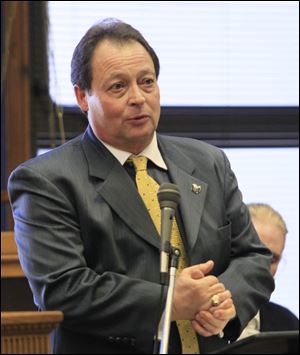
Clerk says data point to rebound in local economy
12/29/2013
Bernie Quilter said the annual filings in Lucas County suggest economic growth in the area.
Foreclosures were down. New car sales were up, and divorces leveled off after a three-year climb. To Lucas County Clerk of Courts Bernie Quilter, the trends are telling signs that the county’s economy got a little bit better in 2013.
“I always say we’re like an airplane taking off,” Mr. Quilter said, using his hand to show a slow, steady ascent. “We’re not out of it yet but we’re starting to climb.”
Indeed.
While more than 4,000 property foreclosures were filed in Lucas County in both 2008 and 2009, that number has been steadily dropping ever since. Through Dec. 15, just 1,855 had been filed for 2013, putting the county on track for the lowest number of foreclosures in at least a decade.
New car sales — as gauged by the number of auto titles filed with the clerk of courts — dipped to 18,997 in 2009 but have been on a steady rise since. Through Dec. 15, Lucas County recorded 23,050 new car sales.
There are other promising signs.
Since Lucas County “hit rock bottom” in 2009, Mr. Quilter said, the number of judgment liens — for unpaid debts — has continued to drop. Domestic violence cases, which increased to 1,166 in 2009, have dropped each year since. And divorces, which slowed to 1,278 in 2009, rose for the next three years as the economy got better. Through Dec. 15, just 1,151 divorce actions had been filed.
Mr. Quilter said married couples are less likely to split up during bad financial times simply because it’s cheaper to stay together, but the drop in divorces filed this year as well as the drop in domestic violence cases may signify there’s less stress in the home with improved economic conditions.
John Gustafson, a bankruptcy lawyer who works as Chapter 13 trustee for the U.S. Bankruptcy Court in Toledo, doesn’t dispute the clerk of courts’ unconventional economic theory.
“I think Quilter’s observations hold water,” he said. “I’ve never done divorce court, but I can tell you people with financial problems often have marital problems, and you have to have a certain amount of economic well-being in order to take the step from not getting along to living separate lives.”
From his vantage point in bankruptcy court, Mr. Gustafson said northwest Ohio saw an overall decline in bankruptcies in 2013 but a slight increase in Chapter 13 repayment cases — a sign to him that the economy is improving ever so slightly. Chapter 13 allows individuals to develop a three to five-year plan to repay their creditors and, most of the time, to keep their homes.
“In the past, home prices had fallen so much people were more interested in walking away from their houses than trying to save them,” Mr. Gustafson said. “We’ve seen a steady increase in house prices — not back to bubble prices — but steady growth.”
That means fewer people are under water with their mortgages — or at least not as far under water — and more people want to keep their homes, he said.
Gbenga Ajilore, associate professor of economics at the University of Toledo, said the court statistics are indeed telling economic indicators, although the unemployment rate as well as home sales and new home construction also are important parts of the equation.
Overall, Mr. Ajilore said, the local economy is improving “very slowly and very surely.”
“For a lot of people, it hasn’t turned around enough,” Mr. Ajilore said. “Yeah, unemployment is going down, but it’s not going down far enough or well enough.”
While the foreclosure crisis in 2008 and 2009 prompted the need for additional staff at the county courthouse, Administrative Judge James Bates said the court will be paying for two, rather than three, extra employees in the clerk of courts and sheriff’s civil office to process foreclosure cases in the new year.
Using a portion of the filing fees from foreclosures, the court began paying for the extra staff when so many foreclosures were being filed that staff couldn’t keep up. The court also hired a first-ever foreclosure magistrate, Mari Taoka, in 2008 to help mediate some of the cases.
“Once we get back to normal — whatever normal is — we’d like to keep the foreclosure magistrate because she’s been very helpful,” Judge Bates said.
Ms. Taoka said more than mediate, “what I really do is push and shove and squeeze the cases to try to get a settlement. Not everyone can keep their homes, but if there’s a way to settle a case without a court judgment, that’s the goal.”
At the peak of the crisis, she had 568 active cases.
“We’d sit at our desks and just start sweating,” Ms. Taoka said.
She handles an average of 300 foreclosures at any given time, and she estimates she’s able to help homeowners reach settlements with their lenders about 30 percent of the time.
“It’s always income dependent, and some people cannot be helped,” she said.
While many of the cases she handles involve people who have lost their jobs or lost overtime pay they had counted on to make their mortgage payments, Ms. Taoka said she’s disheartened to see more and more people who received loan modifications or “Hardest-Hit Fund” assistance facing a second foreclosure.
“Some people have gotten second and third chances and they’re still defaulting, and I’m not sure why,” she said. “It isn’t good.”
Contact Jennifer Feehan at: jfeehan@theblade.com or 419-213-2134.